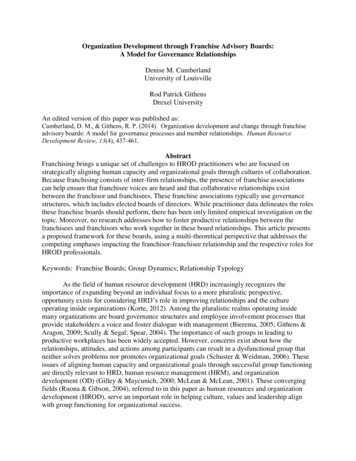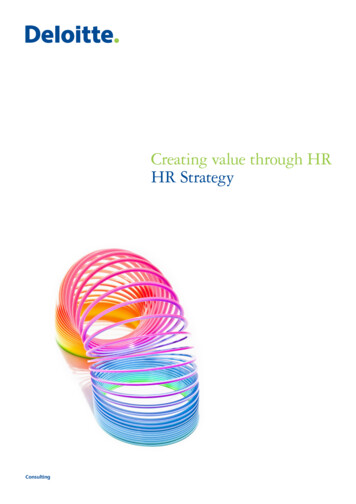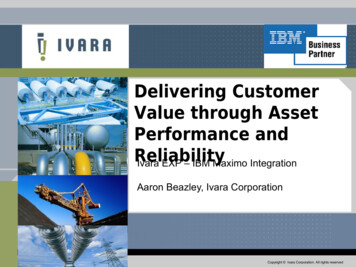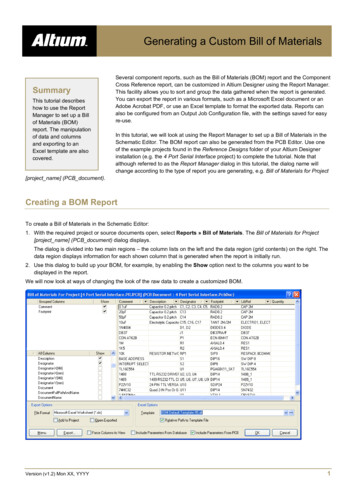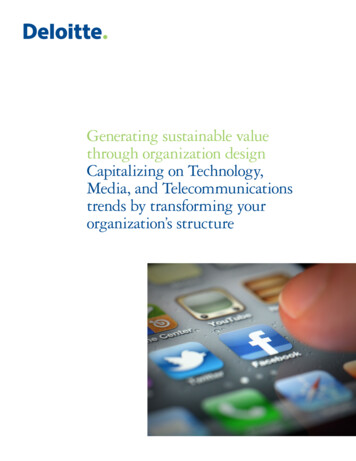
Transcription
Generating sustainable valuethrough organization designCapitalizing on Technology,Media, and Telecommunicationstrends by transforming yourorganization’s structure
A global technology and entertainment company executive openedup her laptop in the living room to wrap up some work when shenoticed something that gave her a wry smile—her mother’s DVDson the bookshelf, her husband’s Netflix rentals below the TV, andher kids’ tablets full of their favorite shows and games. It was quitea collection of past, present, and future. Working on her laptop, theexecutive pored over industry research results about shifting customerpurchases of physical media products to digital content through anyof their devices. This information, paired with a cost-cutting mandate,was the trigger for her company’s urgent strategic business planningthe next day. “How can we avoid our habit of recurring cost-cuttingby restructuring the organization to sustain our ability to drive downlegacy costs from our mature businesses and allow for investment innew revenue streams?” she thought to herself. “I need to push mypeers to think differently about our business.” Revising her onlinesearch, she typed in “Generating Value through Organization Design”and began to prepare for the meeting.Technology, Media, and TelecommunicationsTrends Are Challenging Today’s Business ModelsTechnology, Media, and Telecommunications (TMT) executivesare racing to crack the code of how consumer shifts are signalingopportunities to adjust their organizations’ structures to generatevalue—in reaching their customers, optimizing their experiences,driving financial results, and sustaining performance. Solving theriddle of creating a competitive advantage starts with asking threequestions to define your desired outcomes and transform yourorganizational capabilities: How can we make strategic organizational moves that result incost-efficiencies and enable revenue growth opportunities? What are the organizational outcomes and measures we candefine to sustain the strategic value of these moves and avoidrepeated restructuring efforts? How can we translate these measures into everyday employeeactivities to achieve results?Too often, the questions of how to capitalize on marketopportunities through transforming an organization’s structure arenot thoroughly explored or analyzed prior to action being taken.Subsequently, organizations make decisions under pressure, withminimal understanding of where business value will be generated orsustained, resulting in challenges such as: Recurring cost-cutting “initiatives” Continuous revisions to organizational charts via a “boxes andsticks” approach Repeated organization design initiatives that fail to deliverimproved performanceImproving your organization’s structure and performancestarts with a defined future-state view of valueCreating sustainable value through redesigning your organizationstarts with a clear definition of your desired business outcomes (e.g.,expanding revenue growth, increasing operating margin, driving assetefficiency, and improving execution effectiveness). Many companiesget off to a good start with this approach, but they often strugglewith identifying which capabilities within their organizations requirethe appropriate investment and attention to deliver the value to reachtheir outcomes.TMT Predictions:The converged living room: A plateau approachesGlobal sales of smartphones, tablets, PCs, TV sets, and videogame consoles will exceed 750 billion in 2014. However,future sales are likely to be fairly steady, plateauing at roughly 800 billion after a decade of double digit growth.Bottom line: The living room’s digital completion is nearingcompletion; peak disruption may have passed with no clearwinner, except for the consumer, whose need for entertainmentand media is now better served than ever at the hardware level.Doubling up on pay-TVBy the end of 2014, up to 50 million homes around the worldwill have two or more separate pay-television subscriptions, withthe additional subscriptions generating 5 billion in revenues. Afurther 10 million homes will receive premium programming aspart of their subscription.Bottom line: Content producers should consider how everimproving broadband speeds open up new markets for them;they may no longer have to deal directly with platform ownersto reach end-users. Content owners should however becognizant of the implications of selling direct to the end-user,such as the need to provision local network storage andpayment options. Further, cutting out a distributor may increasemargin, but at the cost of an addressable market.Phablets are not a phadThe 2014 shipments of phablets, smartphones with 5.0-6.9inch screens will represent a quarter of smartphones sold, or300 million units. That is double the 2013 volume, and 10 times2012 sales.Bottom line: Video already represents 40 percent ofdownstream primetime mobile data traffic in North Americaand 36 percent in Europe. Operators will need to consider theimplications of growing phablet penetration on their networks,both at the radio access network level and the backhaul level. Unplanned turnover or inertia Lack of transparency between a company’s organizationalchanges and its target ROISource: TMT Predictions, 2014.2
Deloitte’s Organizational Value Generation (OVG) framework is a value-focused, analytics-driven guide for companies to uncover, define,and organize for business performance across five value amplesof he value of the usefulnessin an organization’sproducts or services—through the eyes of itscustomers (e.g., features,efficiency, performance,and benefits)The value of the overallcustomer exchange (e.g.,money, time, and/orenergy) in obtaining anorganization’s productor serviceThe value of anorganization’s distributionaccess to, or network of,its customers and marketsThe financial valueof the organization’sperformance, such asrevenue, utilization,growth, cash, and stockpriceThe value of anorganization’s abilityto grow, adapt, andevolve to sustainperformance overtime Is the utility of yourproducts or servicessuperior to yourcompetitors? How easily arecustomersable to obtain yourproducts or services? A re distribution channelsto your customers andmarkets streamlined? W hat is your revenuegrowth as a ratio tocosts? What is thedifferentiating utility ofyour product or service? Are all your customersreceiving equal qualityof service? Why? A re the appropriateresources directed tothe right customers andmarkets? W hat is yourorganizational revenuefactor (revenue-toemployee ratio)? A re you makingthe right capabilityinvestments overtime (i.e., talentinnovation)?Theme parks developednew smartphoneapplications that allowcustomers to plan theirvisits before they arriveMobile device companiesdriving increased salesand customer praise forallowing ‘self-check out’of off-the-shelf productsRetailers positionthemselves to meettheir target markets vialocations, steady inventory,and predictable serviceCompanies mayshow strong financialperformance dueto strong economicconditions, but SG&Acost opportunitiesremainMany technologygiants grewexponentially in the2000’s, but lackof value in agilityresulted in missedopportunities intoday’s emergingmarketsCreate a product-focusedorganization structuresupported by sharedservice functions to reduceoperational administrationDevelop a governancemodel and evaluationframework to gather,analyze, and improvecustomer purchaseinteractionsBuild a product or servicedistribution governancemodel to enable businesssegments and regions tomake shared, appropriateinventory movesConduct a spans andlayers analysis to identifywhich levels within yourorganization generatethe greatest ROI (e.g.,cost and revenue peremployee)Identify, invest, andscale the criticalroles and capabilitiesthat consistentlydeliver rapid successin identifying newmarkets or productsFive guiding principles should be taken into account when acompany applies the OVG framework in organization design effortsto create a direct line of sight to each value dimension:1. Identify and prioritize the most relevant value dimensionsthrough analytics-based insightsQuantitative data helps organizations to visualize, assess, select, anddefine: Where will the future-state organization create and sustaindifferentiated value? Which value dimensions are most critical to your organization’ssuccess? What metrics should be measured to guide your transition tothe future state and to evaluate progress toward your desiredlong-term outcomes?3 C an you still be acompetitive forcein the marketplacein 5 to 10 years?Quantitative data in spreadsheets can tell only a part of thestory. Data visualization is a powerful medium for conductingorganizational analysis because it provides a clear and illustrativeview of the gaps between a company’s business strategy, the valueit delivers, and its organization structure. These techniques and toolscan bring data to life, allowing for real-time analysis to make fasterorganization design decisions—and answering a crucial question:“Which elements of my organization design have the highestlikelihood to generate value and why?” Take an iterative approachand start with the data that is readily available to you from internaland external sources to create a baseline analysis for evaluating yourorganization. Many companies are often surprised at how muchinsight they can pull from a small pool of well-organized data.
2. Rally leadership around the identified value dimensions andstrategic business outcomes that will drive the strategy ofthe organization’s structureWhile there may be shifts and iterations to the organization’sstructure throughout your initiative, creating leadership consensuson the value dimensions and the main business outcomes will serveas a foundation for all decisions to follow. Skipping over or rushingthrough this process can result in an unfinished organizationstructure that is unable to meet or sustain the business objectivesset by leadership.3. Select the appropriate combination of “organizationallevers” to execute your business strategyA company’s governance model, organizational capabilities, andworkforce are the primary levers that work together to sustain theorganizational value to drive your business strategy. Selecting theappropriate combination and timing of these levers will enableyou to drive your desired business outcomes—creating the coreelements of your organization’s structure that will foster anexponential impact on value.4. Identify the roles and their relationships with theactivities that impact your value objectives to shapeyour organization’s future stateWhile most jobs in an organization contribute to its operationaleffectiveness, there are always influential roles that drivea disproportionate share of value. These roles make up anorganization’s critical workforce segments—driving significantorganizational value with skills and capabilities that are not easilyreplaced. Identifying these roles as well as their relationships andinteractions that impact your value objectives is imperative toshaping your organization’s future state. Consider these questions: Which relationships have the most direct impact onorganizational performance and value? How effective are those relationships across the organization? What are the most critical business events and interactions thatinvolve those relationships? What roles and capabilities are required in those events andinteractions? How can value and performance be maximized from those rolesand capabilities?Uncovering the most critical workforce segments thatdisproportionately drive value—whether measured by a product’sutility, or a customer’s recommendation, or the promise of a futurerevenue stream—will allow a company to dramatically elevate itsperformance and competitiveness.5. Leverage job design to embed value-generating outcomesinto everyday activitiesMany organizations tend to focus on simply shifting functionalresponsibilities to execute their organization strategy withoutmaking similar efforts to align the job capabilities and dutiesrequired to achieve the desired value-generating outcomes.Sustaining organizational performance starts with clearlyarticulating job capabilities, performance objectives, and careerpaths to make sure individual roles are designed to support thefuture direction of the company—ingraining the business strategyinto everyday actions.OVG Approach Potential BenefitsA Targeted View of Value:Understanding how value is generated throughout theorganization helps you determine which critical workforcesegments will create the greatest business impacts—allowingyour company to prioritize and sequence future-stateorganizational transformations in a way that limits businessinterruption.Cross-functional Capability Identification:The OVG framework also provides the ability to assess whetheror not your operating model and workforce have sufficientsets of skills and capabilities needed for the desired futurestate, helping to identify cross-functional skills throughout theorganization.Organization Design Scenario Planning:Whether companies are going through a merger oracquisition, a shared service initiative or a business/technologytransformation, the OVG framework not only helps youforecast future-state governance, workforce, and organizationalcapability needs, but also provides a multidimensional view ofthe impacts on customers, products, and the business operatinggroups.Integrated, Value-Driven Job Design:Capturing the desired value from an organization’s structurestarts with tailored job descriptions that are linked to the needsof the business to support the overall strategy—creating valueand driving growth over time.4
From Issue to Impact: The Org
organization’s structure . 2 A global technology and entertainment company executive opened up her laptop in the living room to wrap up some work when she noticed something that gave her a wry smile—her mother’s DVDs on the bookshelf, her husband’s Netflix rentals below the TV, and her kids’ tablets full of their favorite shows and games. It was quite a collection of past, present .




